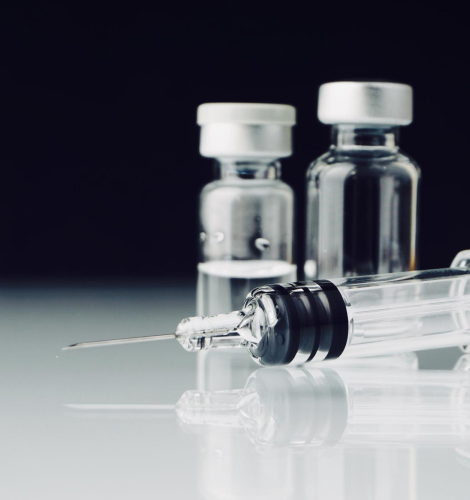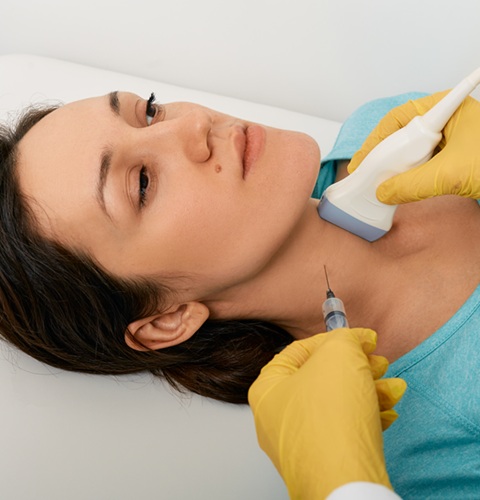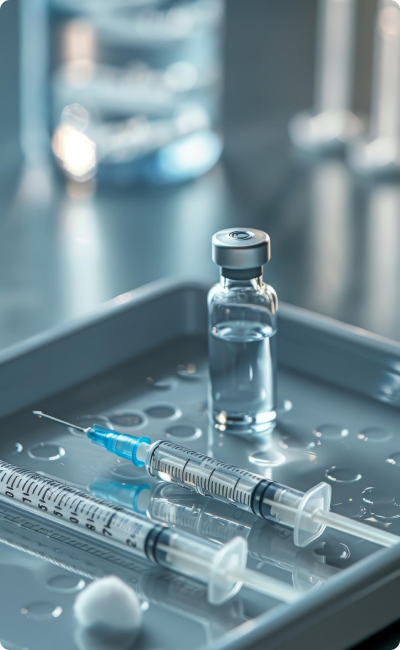
Ethanol ablation is a procedure performed with the goal of substantially decreasing the size of a cystic (fluid filled) thyroid nodule or a thyroglossal duct cyst, and preventing the fluid from returning.
The procedure is performed by using an ultrasound to visually guide a needle through the skin, directly into the growth.
The skin is numbed prior, which requires a pinch from a needle and stinging / burning sensation as the numbing medicine is injected.

Once the needle is in the cystic mass, a syringe is used to aspirate or suck the fluid out of the mass, thus decompressing or shrinking it.
If the fluid is only aspirated from the mass, there is a very high chance for the fluid to come back.

After 95% of the fluid is aspirated, the needle is left in position and the syringe full of the aspirated fluid is twisted off from the needle.
With the needle maintained in the same position, a new syringe full of the Ethanol is twisted on to the needle.
The needle is then confirmed to still be inside the cystic mass by visualizing it on the ultrasound screen and aspirating the small amount of remaining fluid into the syringe.
The needle is then removed from the neck.

The needle is typically in the neck for about a total of ~ 5-7 minutes before it is removed.
The entire procedure takes about 5 – 10 minutes.
Success rates depend on how cystic the thyroid nodule is and are highest when:
Thyroid nodules that are predominantly cystic and deemed good candidates for Ethanol ablation are considered TR 1 (benign) or TR 2 (non-suspicious) risk thyroid nodules and therefore there is no indication for sending cells to rule out cancer.
Thyroglossal duct cysts that are completely cystic are also considered benign and therefore there is no indication for sending cells to rule out cancer.
The Ethanol ablation can be performed on the same day of the consultation in the office, with the entire visit lasting ~ 40 min.
Yes, it is safe for you to drive home from after the procedure.
You can take an anti-anxiety medication at the appropriate amount of time before the procedure.
Please have someone bring you to the office visit and drive you home after taking the anti-anxiety medication.
Repeat Ethanol ablation can be considered if there was a partial improvement and the cystic mass is still deemed to be a good candidate based on its appearance.
Otherwise, the options are continued observation with repeat ultrasounds vs surgery to remove the cystic thyroid nodule or thyroglossal duct cyst if the compressive symptoms are severe enough or continued growth is noted over time.

What are the risks of an Ethanol ablation?
Sometimes the fluid is too thick to suck out with a needle and therefore the procedure cannot be performed.
Unfortunately, there is no way to tell if the fluid is too thick until the procedure is attempted.
Sometimes despite a properly performed procedure, the fluid of the cystic mass can return.
Introducing a needle into any cystic mass has a risk of causing infection in the cyst.
The risk for infection with Ethanol ablation is low, ~ 2%.
Signs of infection include redness, swelling, and pain near the procedure sight.
Bleeding during or after Ethanol ablation resulting in significant swelling and bruising (aka hematoma) is very rare; < 1%.
The consultation and Ethanol ablation can be performed on the same day, with the entire appointment taking ~ 40 min.